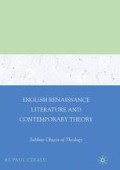Abstract
Richard Crashaw’s poetry, often described as Baroque in nature, provides the most comprehensive illustration of the ways in which a jouissance of the body, or the feminine non-all without exception, operates through or within the fundamental jouissance of the drives, or masculine logic of exception. In Crashaw’s work, the feminine non-all does not, however, make itself felt where we would expect it, namely in the poetry that recounts the lives and tribulations of female mystics and heretics like Saint Teresa and Mary Magdalene. On the contrary, these poems operate firmly within the masculine realm of exception. It is in Crashaw’s Christology, in his unrelenting concern to represent Christ’s material body, that one detects something approaching the non-all without exception. In order to make such an argument, I will be claiming further that one needs to read Crashaw’s theology as fundamentally immanentist rather than transcendent in nature, an orientation that itself is motivated by Crashaw’s embrace of some fundamental Baroque tenets.
Access this chapter
Tax calculation will be finalised at checkout
Purchases are for personal use only
Preview
Unable to display preview. Download preview PDF.
Notes
On Lacan’s interpretation of Sartre’s account of the “look,” see Jacques Lacan, The Four Fundamental Concepts of Psycho-Analysis (New York: W. W. Norton, 1981), 84–85. On the relationship between the look and gaze, see also Kaja Silverman, The Threshold of the Visible World (New York: Routledge, 1996), passim ch. 5.
See Mladen Dolar, “At First Sight,” in Gaze and Voice as Love Objects, eds. Renata Salecl and Slavoj Ž ižek (Durham, NC: Duke University Press, 1996), 139.
All cites from Crashaw’s poetry are taken from Richard Crashaw, The Verse in English of Richard Crashaw (New York: Grove Press, 1949). Line numbers will be cited parenthetically in the text.
Richard Gibbons, The Practical Methode of Meditation (London, 1614). Cited in Louis L. Martz, The Poetry of Meditation: A Study in English Religious Literature of the Seventeenth Century (New Haven, CT: Yale University Press, 1965), 27.
Roland Barthes, Sade, Fourier, Loyola, trans. Richard Miller (New York: Hill and Wang, 1976), 69.
Ibid., 165.
Marc F. Bertonasco, Crashaw and the Baroque (Tuscaloosa: University of Alabama Press, 1971), 89.
Slavoj Ž ižek, Looking Awry: An Introduction to Jacques Lacan Through Popular Culture (Cambridge: Massachusetts Institute of Technology Press, 1993), 110.
Ibid.
Heinrich Wolfflin, Renaissance and Baroque, trans. Kathrin Simon (Ithaca, NY: Cornell University Press, 1966), 33.
Ibid., 62.
Ibid., 81.
Jacques Lacan, On Feminine Sexuality and the Limits of Love and Knowledge, Book XX, Encore, 1972–1973, trans. Bruce Fink (New York: W. W. Norton, 1998), 76.
Ibid.
Bruce Fink, A Clinical Introduction to Lacanian Psychoanalysis: Theory and Technique (Cambridge, MA: Harvard University Press, 1997), 187.
Slavoj Ž ižek, “Woman is One of the ‘Names-of-the-Father,’ or How Not to Misread Lacan’s Formulas of Sexuation,” Lacanian Ink 10 (1995). http://www.lacan.com/zizwoman.htm.
Teresa d’ Avila, The Life of St. Teresa of Avila: Including the Relations of Her Spiritual State, trans. David Lewis (Maryland: The Newman Press, 1962), 138–39.
Ibid., 139.
Ibid., 162.
Cited in Anthony Saville, Leibniz and the Monadology (London: Routledge Press, 2000), 235.
Gilles Deleuze, The Fold: Leibniz and the Baroque, trans. Tom Conley (Minneapolis: University of Minnesota Press, 1993), 35.
Ibid., 23–24.
Ibid., 52.
Ibid., 53.
Ibid.
Against the conventional understanding of Deleuzian metaphysics, Alain Badiou has recently argued that Deleuze’s philosophy does ultimately rest on a Platonizing notion of the univocity of being. See Alain Badiou, Deleuze: The Clamor of Being, trans. Louise Burchill (Minneapolis: University of Minnesota Press, 2000).
Ibid., 125.
Walter Benjamin, The Origin of German Tragic Drama, trans. John Osborne (London: New Left Books, 1977), 166.
Ibid., 175.
Cited in Susan A. Handelman, Fragments of Redemption: Jewish Thought and Literary Theory in Benjamin, Scholem, and Levinas (Bloomington: Indiana University Press, 1991), 131.
Jacques Lacan, On Feminine Sexuality: Jacques Lacan and the ecole Freudienne, eds. Juliet Mitchell and Jacqueline Rose, trans. Jacqueline Rose (New York: W. W. Norton, 1982), 113.
Ibid., 117.
Ibid., 77.
Ibid., 103.
Paul Verhaeghe, “Lacan’s Answer to the Classical Mind/Body Deadlock: Retracing Freud’s Beyond,” in Reading Seminar XX: Lacan’s Major Work on Love, Knowledge, and Feminine Sexuality, eds. Suzanne Barnard and Bruce Fink (New York: State University of New York Press, 2002), 132.
Richard Boothby, Freud as Philosophy: Metapsychology after Lacan (London: Routledge, 2001), 246.
Ibid, 247.
Graham Hammill, “Steps to the Temple,” in South Atlantic Quarterly 88:4 (1989): 947. For an alternative Lacanian interpretation of Cra-shaw’s epigrams, see Gary Kuchar, Divine Subjection: The Rhetoric of Sacramental Devotion in Early Modern England (Pittsburgh: Duquesne University Press, 2005), 114–18.
Slavoz Zižek, The Metastases of Enjoyment: Six Essays on Women and Causality (London: Verso, 1994), 104.
Copyright information
© 2007 Paul Cefalu
About this chapter
Cite this chapter
Cefalu, P. (2007). Baroque Monads and Allegorical Immanence: A Reassessment of Richard Crashaw’s Imagery. In: English Renaissance Literature and Contemporary Theory:. Palgrave Macmillan, New York. https://doi.org/10.1057/9780230607491_3
Download citation
DOI: https://doi.org/10.1057/9780230607491_3
Publisher Name: Palgrave Macmillan, New York
Print ISBN: 978-1-349-53730-3
Online ISBN: 978-0-230-60749-1
eBook Packages: Palgrave Literature & Performing Arts CollectionLiterature, Cultural and Media Studies (R0)

